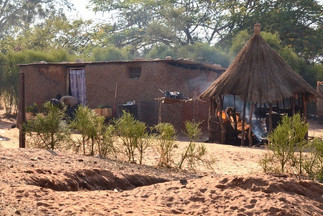BOTANICAL ENCOUNTERS: Mopane Woodlands
- k-england
- Jul 31, 2022
- 3 min read
Updated: Sep 1, 2022
Text and photos by Ida Rigby, for Let’s Talk Plants! August 2022.

Mopane Woodlands
The mopane woodlands of southern Africa are usually dense, mixed forests. The mopane, Colophospermum mopane, is often referred to as the butterfly tree due to its winged leaves.
In Greek, Colophos refers to an “oily seed” and the turpentine-like scent of the resinous seeds and leaves. Mopane is a local name for the tree. Mopane trees adapt to dry winters by losing their leaves, and to heat by folding them inward and downward to expose only a small surface to the sun. The trees bloom in summer which is December and January in southern Africa. Kidney-shaped seed pods appear in April through June after the blossoms are wind pollinated. The leaves turn a bright yellow in fall and a rusty brown in winter. In Botswana, the mopanes grow in the porous, nutrient poor Kalahari sands; mopanes can also tolerate clay and alkaline soils. They cast a dappled shade, which encourages scrubby undergrowth. Lush mopane “cathedral groves” grow in the Okavango Delta. Mopane wood is hard, dense and termite resistant, so it is used for village homes, storage bins and kraal fencing.
(Note the green euphorbia fencing. This plant is thought to deter mambas and other snakes.)
The wood burns for a long time so it is good for heating, cooking and making charcoal in pits dug into the earth. Men on bicycles carry large bags of homemade charcoal to market. A mopane tree can grow up to 80 feet, but passing elephant herds prune them, so many forests are stunted.
The elephant pruned mopane forests bring to mind eerie, haunting surrealist landscapes. Elephants not only prune the young trees, but also strip the gray bark off of mature trees in order to access the mineral rich cambium layer beneath.

Unfortunately, when elephants cannot follow their ancient migration routes and are confined to reserves, they concentrate their feeding and often girdle the trees, creating ghostly dead forests.

This photo of the magnificent tusker Mr. Linyanti, which is the name of his reserve, was taken through the mesh window of my canvas tent as he contentedly munched on the large mopane tree by the “window.” I could hear him breathing into his huge lungs. Humans and other mammals, particularly elephants and antelope, eat the leaves, which are protein rich even when dry in winter when other foliage is no longer available.
In winter, elephants knock over mopanes to feast on the roots and roll

branches in their mouths to access the nutritious layers. Humans and baboons pick “mopane manna,” a sweet waxy substance exuded by the juvenile stage of a sap-sucking psyllid, off the leaves.

Bees nest in the hollows of the trees, supplying honey. Hornbills nest in cavities. The most useful product of the mopane is the protein (60%), fat and mineral rich “mopane worm.” It is the larvae of a very large moth that lays its eggs on the leaves at the end of winter. In summer, the larvae strip the trees of leaves, which then grow back, and village women harvest the “worms” and roast or boil the caterpillars in salty water before drying them to sell at local markets. They are a good snack and tasty (and nutritious) when simmered in stews. When dried they can be stored for months. The “worms” are now very important for Botswana’s economy as they supply an international supermarket trade. Currently thousands of tons are harvested, and harvesting needs to be restricted because the moths are now endangered. Villagers have long chewed mopane twigs for toothbrushes and twisted the bark for twine. The leaves are used to heal wounds and to treat bleeding gums, kidney stones, gout and stomach and tooth aches. The caterpillars of one of the moths that lays eggs on mopane leaves spins a silk cocoon, which is harvested threads to weave cloth. The dense wood is used for clarinets and saxophones. The red heartwood supplies a red veneer for finishing the interiors of railroad car cabins.

The stunning autumnal colors last into winter. The brown hues of winter’s dry leaves offer excellent camouflage for predators such as the African painted dogs.

The dense gray branches of the stunted forests give cover and camouflage to young, stalking lions ...

... as well as to their prey such as zebras.
Even elephants are hidden by these tangled forests.
On safari in Zambia, one visiting tourist found that mopane trees, along with elephant dung known as “medicine balls,” provided an excellent gym away from home.

































